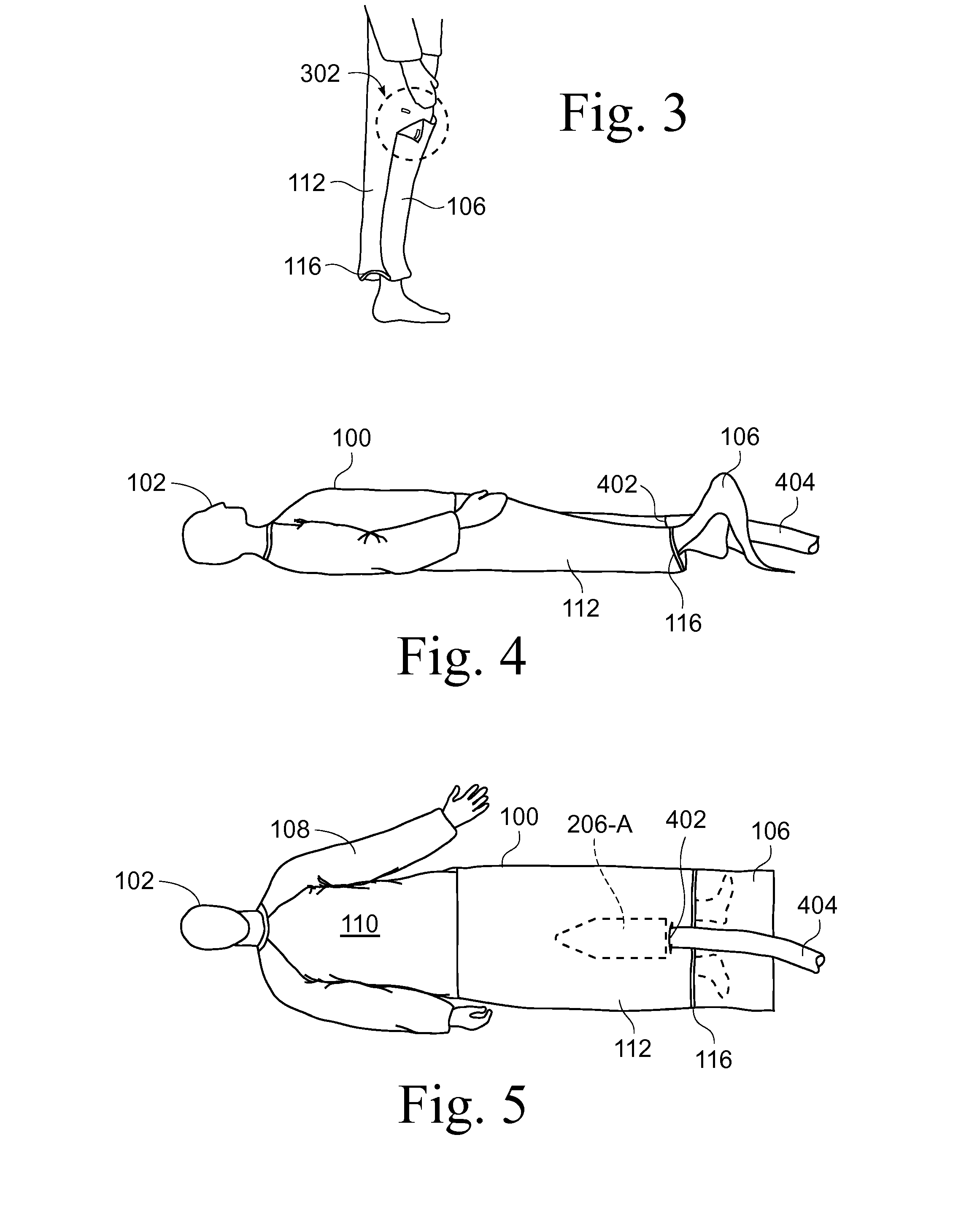Prewarming Gown
a pre-warming gown and body technology, applied in the field of pre-warming gowns, can solve the problems of increasing the core temperature, reducing comfort, and thus sweating, and restricting patient mobility by full-body blankets, so as to reduce the increase in core temperature, and maintain the effect of core temperature constan
- Summary
- Abstract
- Description
- Claims
- Application Information
AI Technical Summary
Benefits of technology
Problems solved by technology
Method used
Image
Examples
fourth embodiment
[0080]FIG. 11 illustrates a lateral view of a distributor 206-D for the gown 100. In the illustrated embodiment, the distributor 206-D is accessed through the drape 106 of the gown. The distributor 206-D extends from the drape 106, past the feet, between the legs, and toward the crotch area of the patient 102.
[0081]In the passive configuration, the distributor 206-D is deflated and rests against a portion of the drape 106 and the inside anterior surface of the leg portion 112 of the gown 100. The base 606 at the proximal end of the distributor 206-D is attached to the inside surface of the drape 106. The distal end of the distributor 206-D is attached to the inside anterior surface of the leg portion 112. In one embodiment, the proximal end of the distributor 206-D is tethered to the inside surface of the drape 106 in the region proximate the hem 116. When the drape is in the stowed position, the deflated distributor 206-D folds or rolls with the drape 106.
[0082]As discussed above i...
fifth embodiment
[0083]FIG. 12 illustrates a lateral view of a distributor 206-E for the gown 100. In the illustrated embodiment, the distributor 206-E has a first section 1202 and a second section 1204 joined at a seam 1206. The first section 1202 is substantially external to the gown 100 and is not air permeable. The second section 1204 is internal to the gown 100 and is air permeable.
[0084]The proximal end of the first section 1202 of the distributor 206-E is attached to the outside anterior surface of the leg portion 112 proximate the hem 116 of the gown 100. The first section 1202 of the distributor 206-E extends through a slit 1208 to the inside of the gown 100. The slit 1208 is located proximate the hem 116 in the leg portion 112 of the gown 100 and is positioned substantially between where the legs of the patient 102 contact the leg portion of the gown 100 with the patient's feet shoulder width apart. The second section 1204 of the distributor 206-E is located within the gown 100 and extends...
sixth embodiment
[0087]FIG. 13 illustrates a lateral view of a distributor 206-F for the gown 100. In the illustrated embodiment, the gown 100 includes an inner layer 1302 adjacent the drape 106 and the leg portion 112. The inner layer 1302 is air permeable. The peripheral edge of the inner layer 1302 is joined to the drape 106 and the leg portion 112 of the gown 100, which are not air permeable, to create a distributor or chamber 206-F. The inner layer 1302 is joined to the drape 106 proximate the distal end of the drape 106. The inner layer 1302 extends toward the waist of the patient 102. In one embodiment, the inner layer 1302 is joined to the leg portion 112 proximate the crotch area of the patient 102. In one embodiment, the chamber 206-F is between the legs of the patient 102, and extends from the region proximate the distal end of the drape 106 towards the crotch area of the patient 102. In another embodiment, the distributor 206-F has a width that extends past the legs of the patient 102 su...
PUM
 Login to View More
Login to View More Abstract
Description
Claims
Application Information
 Login to View More
Login to View More - R&D
- Intellectual Property
- Life Sciences
- Materials
- Tech Scout
- Unparalleled Data Quality
- Higher Quality Content
- 60% Fewer Hallucinations
Browse by: Latest US Patents, China's latest patents, Technical Efficacy Thesaurus, Application Domain, Technology Topic, Popular Technical Reports.
© 2025 PatSnap. All rights reserved.Legal|Privacy policy|Modern Slavery Act Transparency Statement|Sitemap|About US| Contact US: help@patsnap.com



